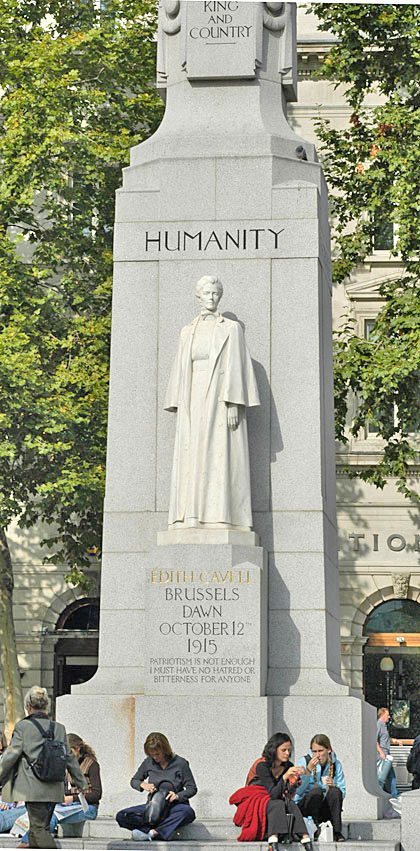MEMORIALS |
EDITH CAVELL In 1915 Edith Cavell, a British nurse, was shot at dawn by a German firing squad in Brussels in 1915 for helping hundreds of allied soldiers escape from occupied Belgium. In Britain there was a huge public outcry. “Everybody must feel disgusted at the barbarous actions of the German soldiery in murdering this great and glorious specimen of womanhood,” wrote Arthur Conan Doyle at the time. | more However, when unveiled in 1920 the Edith Cavell statue, designed by George Frampton, who charged no fee, bore the patriotic inscription, “For King and Country’, with no counterpoise. Dick Sheppard, then Vicar of St Martin-in the Fields (and later founder of the Peace Pledge Union), had watched the site preparations from his study window, and curious as to how the statue was going to look, he went out in his pyjamas the night before the unveiling and crept under the covering (being questioned by a police constable, who happened to be passing). When Dick saw the patriotic inscription, he was moved to campaign, with others, until in 1924 were added a version of her last message, the evening before her execution at dawn on 12 October 1915. Stirling Gahan, Anglican chaplain in Brussels, gave two versions of what she said during her late evening conversation with him on 11 October. At the time, he sent a typed note to the US legation in Brussels, which had tried to intervene with the German authorities on her behalf, that she had said, “Patriotism is not enough. I must have no hatred or bitterness towards anyone”. He also wrote a manuscript account giving a fuller version: “Patriotism is not enough. It is not enough to love one’s own people, one must love all men, and hate none …”. The version added to the statue is a form of the earlier version, slightly truncated because of space constraints on the monument: 'Patriotism is not enough. I must have no hatred or bitterness for anyone. |
v |
||
|
Peace Pledge Union, 1 Peace Passage, London N7 0BT. Tel +44 (0)20 7424 9444 contact | where to find us
